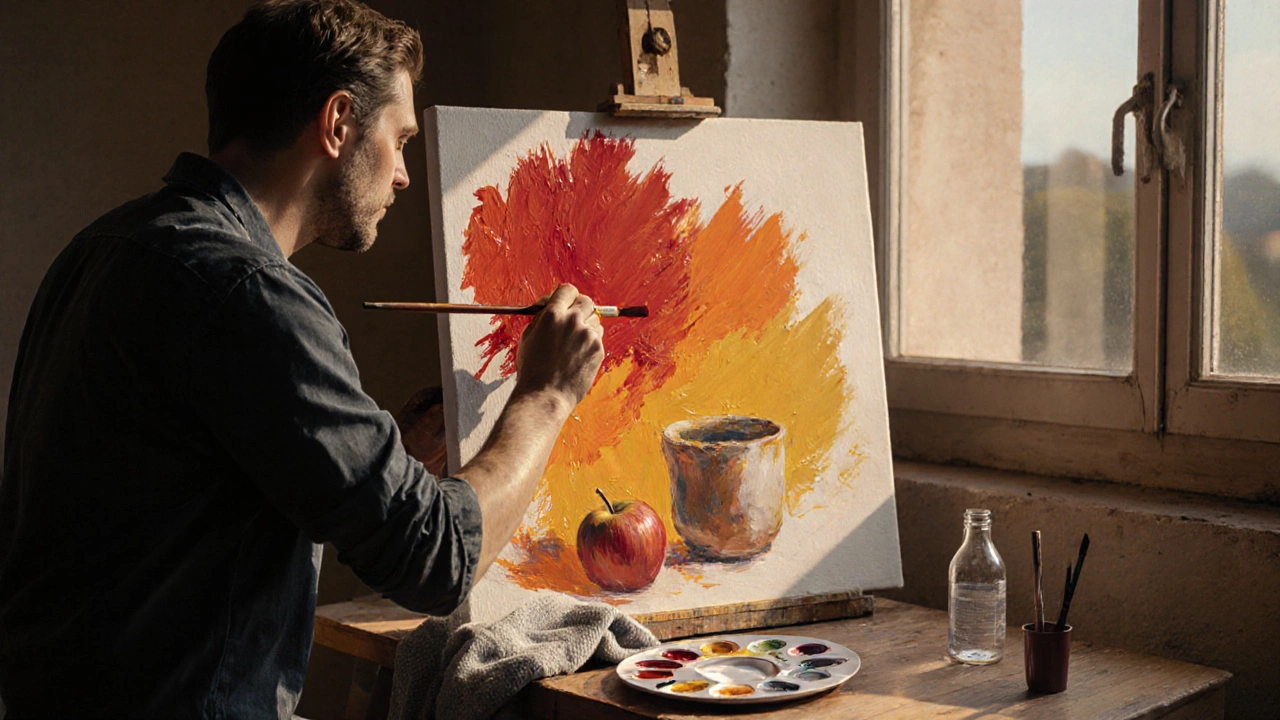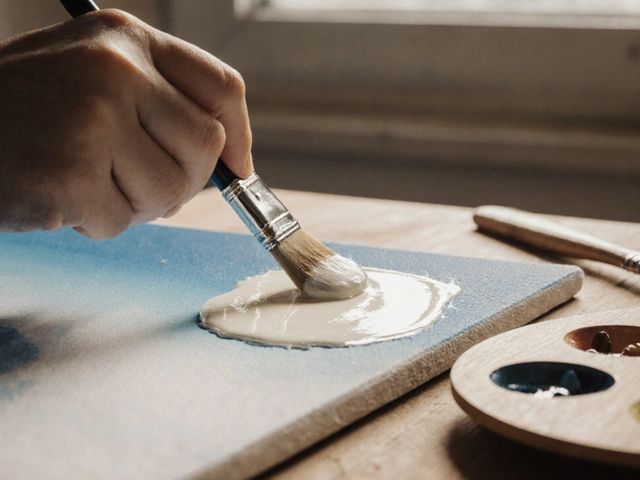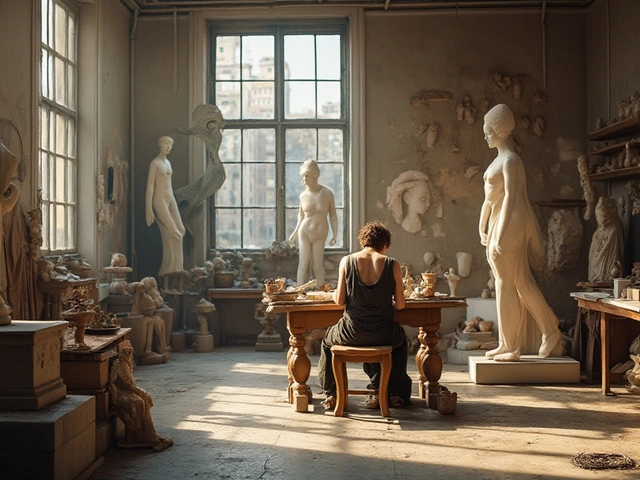Alla Prima Color Mixer
See how colors mix directly on the canvas in alla prima technique. Unlike traditional painting, alla prima artists mix colors on the canvas, not on the palette. This tool demonstrates how the limited palette (white, cadmium yellow, cadmium red, ultramarine blue, and burnt umber) creates vibrant results.
Mixed Color
Alta prima is a painting method where artists finish a piece in one session, applying wet paint directly onto wet paint without waiting for layers to dry. It’s not just a shortcut-it’s a deliberate style that captures light, movement, and emotion in a single, confident stroke. If you’ve ever seen a portrait where the brushwork feels alive, or a landscape that seems to shimmer with fresh color, you’re likely looking at an alla prima painting.
Where Did Alla Prima Come From?
The term comes from Italian, meaning "at first attempt." It became popular in the 17th century among Dutch and Flemish painters like Frans Hals and Rembrandt. They didn’t have slow-drying mediums or digital references-painting had to be fast, intuitive, and responsive to changing light. Hals painted portraits of merchants and soldiers with loose, energetic brushstrokes that looked finished in minutes, not weeks. His subjects didn’t sit still for months; they sat for an hour, and he captured their spirit before it slipped away.
By the 19th century, the Impressionists adopted the technique wholeheartedly. Monet painted the same haystack at different times of day, finishing each version in a single morning. He didn’t blend colors on the palette-he mixed them right on the canvas. The result? Vibrant, shifting light that felt real, not staged. Today, alla prima is still the go-to method for plein air painters, portrait artists, and anyone who wants to paint with immediacy.
How Does Alla Prima Work?
Unlike traditional layering methods that rely on glazes and underpaintings, alla prima skips the buildup. You start with a loose sketch or wash, then build form and color directly on the canvas. The key is working quickly before the paint dries. Oil paint stays workable for hours, especially if you use mediums like linseed oil or Liquin, but the window for blending is narrow-usually under two hours.
Here’s how it typically unfolds:
- You begin with a thin, neutral wash to block in shapes and values-think burnt umber or raw sienna diluted with odorless mineral spirits.
- Then you lay in the darkest shadows with thick paint, using a stiff brush or palette knife.
- Next, you push the midtones and highlights directly on top, often using the same brush without cleaning it between colors.
- Colors blend on the canvas, not the palette. A stroke of cadmium red next to yellow ochre becomes orange right where it lands.
- You finish with fine details-eyes, edges, texture-using a smaller brush or even the tip of a palette knife.
The magic happens when you stop before overworking the paint. Too much blending turns the image muddy. Too little, and it looks unfinished. The best alla prima pieces feel spontaneous, but they’re not random. Every stroke is intentional.
What Makes Alla Prima Different From Other Techniques?
Traditional oil painting often involves multiple sessions. Artists build up layers: an underpainting in grayscale, then glazes of transparent color, then final highlights. It’s precise. It’s slow. It can take weeks.
Alta prima is the opposite. It’s direct. It’s physical. You’re not hiding anything. The brushstrokes, the texture, the mistakes-they’re all part of the final image. It’s like improvisational jazz versus a symphony. One is carefully composed. The other is alive in the moment.
Compare this to watercolor, where transparency and flow are essential, or acrylic, which dries too fast for blending. Oil paint’s slow drying time is what makes alla prima possible. You have the luxury of time to adjust, but not enough to overthink.
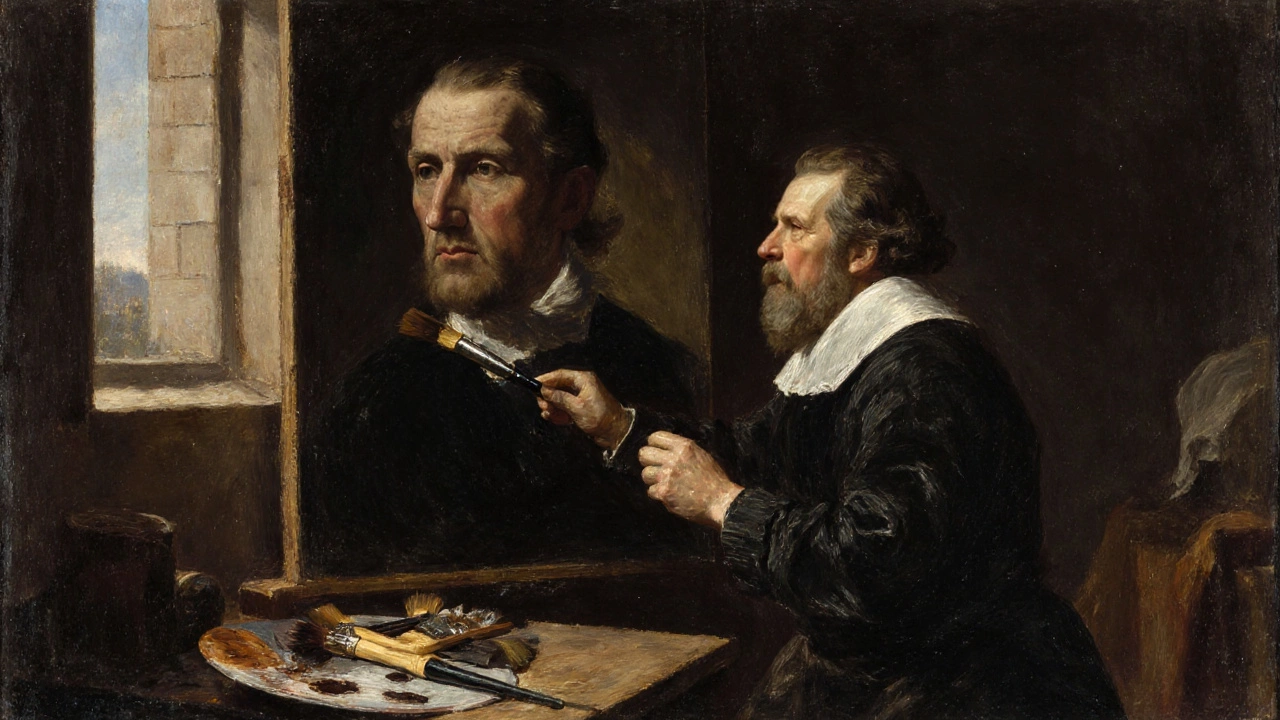
What Tools Do You Need?
You don’t need much, but the right tools make a big difference:
- Brushes: Stiff hog bristle brushes for laying in paint, synthetic rounds for details. Avoid soft sables-they don’t hold enough paint for thick application.
- Palette: A large, non-porous surface. White ceramic or glass works best so you can see true colors.
- Mediums: Linseed oil for slow drying, Liquin for faster drying and gloss. Avoid turpentine alone-it evaporates too quickly and can crack the paint.
- Cleaners: Odorless mineral spirits for thinning and cleaning. Keep a rag handy-you’ll wipe brushes often.
- Canvas: Pre-primed linen or cotton. A slightly textured surface holds paint better than smooth panels.
Some artists use a limited palette-just white, cadmium yellow, cadmium red, ultramarine blue, and burnt umber. That’s all you need to mix most colors. Less choice means faster decisions and stronger harmony.
Why Do Artists Choose Alla Prima?
It’s not just about speed. It’s about truth.
When you paint alla prima, you’re forced to make decisions in real time. There’s no going back. You can’t fix a weak shape with ten layers of glaze. You have to see the form clearly and commit to it. That builds confidence. It sharpens your eye.
Many professional artists use it for studies. A 30-minute portrait sketch in alla prima can teach you more than a week of slow rendering. You learn how light falls on a cheekbone, how shadows connect, how color changes under different conditions.
It’s also deeply satisfying. There’s a rhythm to it-mix, apply, adjust, stop. You finish with a sense of accomplishment, not exhaustion. You didn’t labor over it-you danced with it.
Common Mistakes and How to Avoid Them
Even experienced painters mess up with alla prima. Here are the most common errors:
- Muddying colors: Over-blending turns vibrant hues into brown sludge. Solution: Use clean brushes for each major color. Don’t scrub. Tap or drag the brush lightly.
- Painting too thin: Thin paint doesn’t hold texture or form. Solution: Use thick, buttery paint. Let the brush carry the pigment.
- Waiting too long: If the paint starts to skin over, it won’t blend. Solution: Work in small sections. Finish one area before moving to the next.
- Ignoring value: Color looks right, but the light and dark don’t read. Solution: Squint. If you can’t tell what’s light and what’s dark, the painting won’t work.
- Trying to be perfect: Alla prima thrives on energy, not polish. Solution: Embrace the roughness. A slightly uneven edge can feel more real than a perfectly blended one.
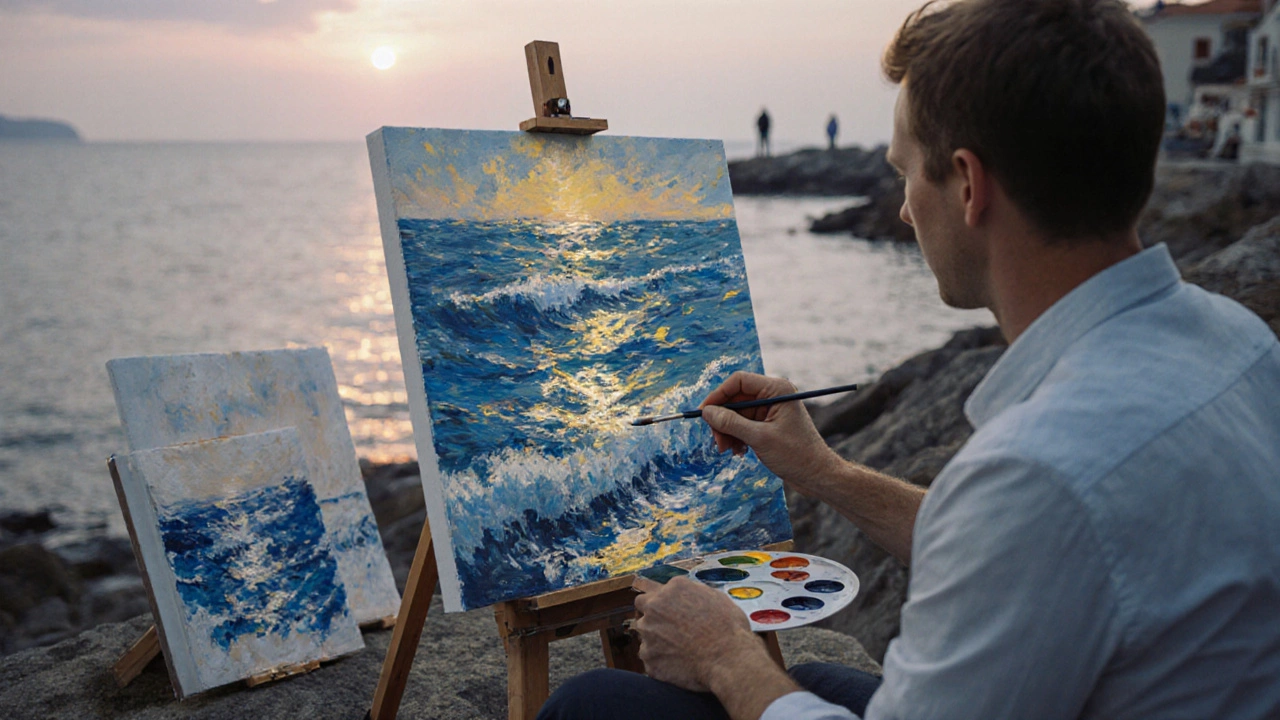
Who Uses Alla Prima Today?
It’s alive in studios, parks, and coastal towns around the world. In Vancouver, where the light shifts fast and rain can end a session in minutes, plein air painters rely on alla prima. Artists like Richard Schmid and Bob Ross made it famous to the public-Ross with his soothing voice and quick brushwork, Schmid with his masterful control and teaching.
Contemporary artists like Amy Sherald and Kehinde Wiley use it in portraits, blending the immediacy of alla prima with the precision of realism. Even in animation and concept art, the technique is used for quick character studies and mood boards.
It’s not just for professionals. Thousands of hobbyists take online classes in alla prima because it’s accessible. You don’t need years of training. You need a canvas, some paint, and the courage to make the first stroke.
How to Start Painting Alla Prima
Here’s a simple way to begin:
- Set up a still life with three objects-a cup, an apple, a cloth. Place them near a window.
- Use a limited palette: titanium white, cadmium yellow, cadmium red, ultramarine blue, burnt umber.
- Sketch the shapes lightly with a thin brush and burnt umber.
- Start with the darkest areas. Paint the shadow under the cup, the dark part of the apple.
- Then push the light areas. Don’t mix on the palette-put yellow next to white, red next to brown. Let them mix on the canvas.
- Finish in 45 minutes. Stop when you feel it’s alive, not when you think it’s "done."
Don’t worry if it looks rough. The first few times, it will. But each one teaches you something new. After five sessions, you’ll start to see the world differently. You’ll notice how light catches a shoulder, how a shadow isn’t just gray-it’s violet, green, or even orange.
Final Thoughts
Alta prima isn’t about speed. It’s about presence. It’s about trusting your eye, your hand, and your instincts. It’s the closest thing painting has to a conversation-with light, with color, with the moment.
There’s no right or wrong way to do it. Only more alive or less alive. And once you’ve felt the energy of a single brushstroke that captures a whole feeling, you’ll never want to paint any other way again.
Is alla prima the same as wet-on-wet painting?
Yes, alla prima is often called wet-on-wet painting because you apply fresh paint over still-wet layers. But not all wet-on-wet techniques are alla prima. For example, watercolor artists use wet-on-wet too, but they work with transparency and flow, not thick oil paint. Alla prima specifically refers to oil or acrylic painting done in one session with direct, unblended strokes.
Can you use alla prima with acrylics?
Yes, but it’s harder. Acrylics dry much faster than oils-sometimes in minutes. To use alla prima with acrylics, you need retarders or slow-drying mediums, or you have to work in very small sections. Many artists use a combination: start with acrylic for the underpainting, then switch to oil for the final alla prima layer.
Do you need to varnish an alla prima painting?
Yes, but not right away. Oil paint takes 6 to 12 months to fully cure, even if it feels dry to the touch. Varnishing too early can trap solvents and cause yellowing. Wait until the painting is completely dry, then apply a removable varnish like Gamvar to protect the surface and even out the sheen.
Can beginners learn alla prima?
Absolutely. In fact, many teachers recommend it for beginners because it forces you to focus on big shapes, values, and color relationships instead of getting lost in details. You learn to see faster and paint with more confidence. Start with short 30-minute studies-just one face, one hand, one flower. Don’t aim for perfection. Aim for honesty.
Why does alla prima look so different from traditional oil paintings?
Traditional oil paintings often have smooth, blended surfaces built up over weeks. Alla prima paintings keep the energy of the brushstroke visible. You see the artist’s hand-the speed, the hesitation, the boldness. It’s less about polish and more about presence. That’s why they often feel more alive, even if they’re less detailed.
Alta prima doesn’t require years of training. It requires attention. And that’s something anyone can learn.
